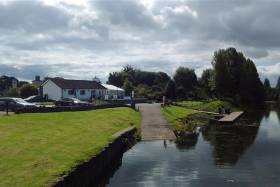Displaying items by tag: Toome Canal
Toome Waterways Heritage Centre & Café Now Open
#InlandWaters - Toome-based development group Tidal Ltd has officially opened a new waterways heritage centre and café on the site of the former lockkeeper’s cottage on the Toome Canal in Co Antrim.
Working with Lough Neagh Landscape Partnership and Waterways Ireland, the group secured funding from the Heritage Lottery Fund through its Landscape Partnership Fund to undertake regeneration and refurbishment of the cottage, quay and wider canal amenity area.
The new centre houses a comprehensive interpretative display that covers the history of the canal and its importance as a gateway linking the North Coast to Lough Neagh as well as information on the community, natural environmental and wider cultural and industrial heritage of the site.
Speaking at the launch, Tidal chairman John Laverty outlined the benefits the new project will bring to the area.
“We at Tidal are delighted to have been instrumental in achieving the realisation of this wonderful new facility. From a cultural, educational, leisure, tourism and historical perspective, we see this reinvention of the disused lockkeeper’s cottage as something which will further enrich the tapestry of Toome,” he said.
Conor Jordan, chair of Lough Neagh Partnership and the Landscape Partnership Forum, complemented all involved in the development and delivery of the Waterways Heritage Centre and Café.
“This is an excellent example of how partnership working across the voluntary and statutory sectors can lead to the delivery of a new facility that helps promote a greater understanding of our landscape heritage whilst contributing to both the social and economic development of the wider lough,” he said.
Jim McGreevy, Heritage Lottery Fund NI committee member, added: “Landscapes are more than just beautiful scenery, they are also living, working places, full of stories and experiences. This new facility will give visitors an insight into past life in and around Lough Neagh and we wish the Partnership every success with this new project.
“HLF’s Landscape Partnership programme encourages a mix of projects and activities which not only help to protect the landscape but also to give communities the opportunities to explore and share their heritage with others. We are delighted that National Lottery players’ money will help Lough Neagh’s communities celebrate the wonderful heritage on their doorsteps.”
Waterways Ireland chief executive Dawn Livingstone praised the success of the partnership between the groups at Toome to bring this project to fruition.
“Waterways Ireland, as the custodian of a number of unique heritage buildings along the waterways, welcomes opportunities to work alongside partners to give these historic buildings a modern and useful purpose,” she said. “Today we see the outcome of one of these working partnerships with the beautiful restoration of this lockhouse to provide a hub for the community and an attraction for tourists to the River Bann and Lough Neagh.”
The new centre and café will be open Monday to Saturday from 9am to 5pm and will be available for both organised group visits and day trippers.
This is one of 27 integrated Heritage Lottery Fund landscape programme projects which aim to protect the built, cultural and natural heritage of the lough being delivered by Lough Neagh Landscape Partnership.




























































